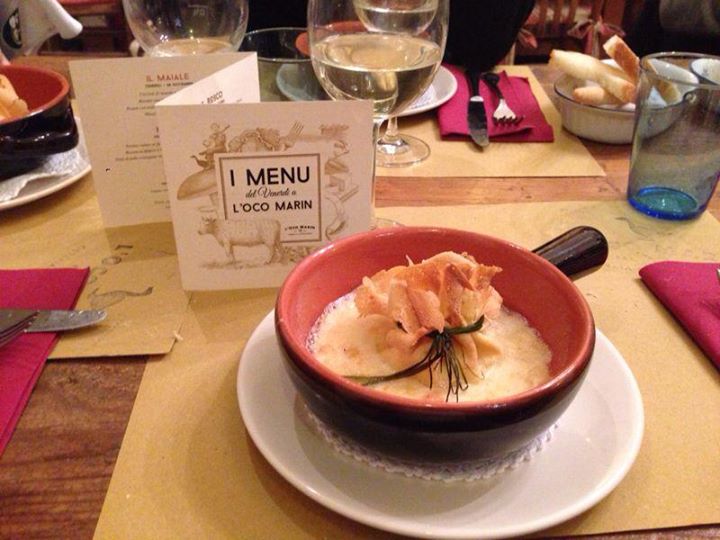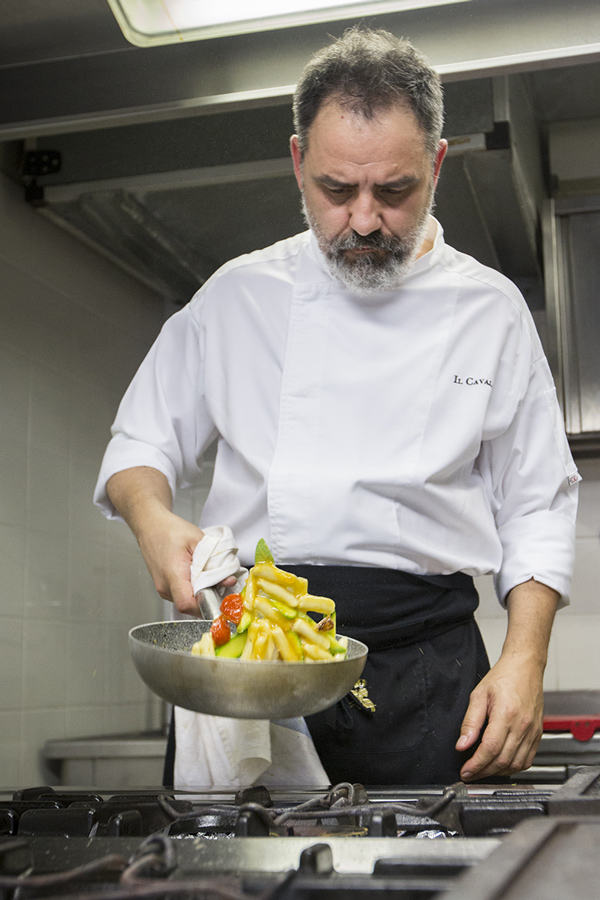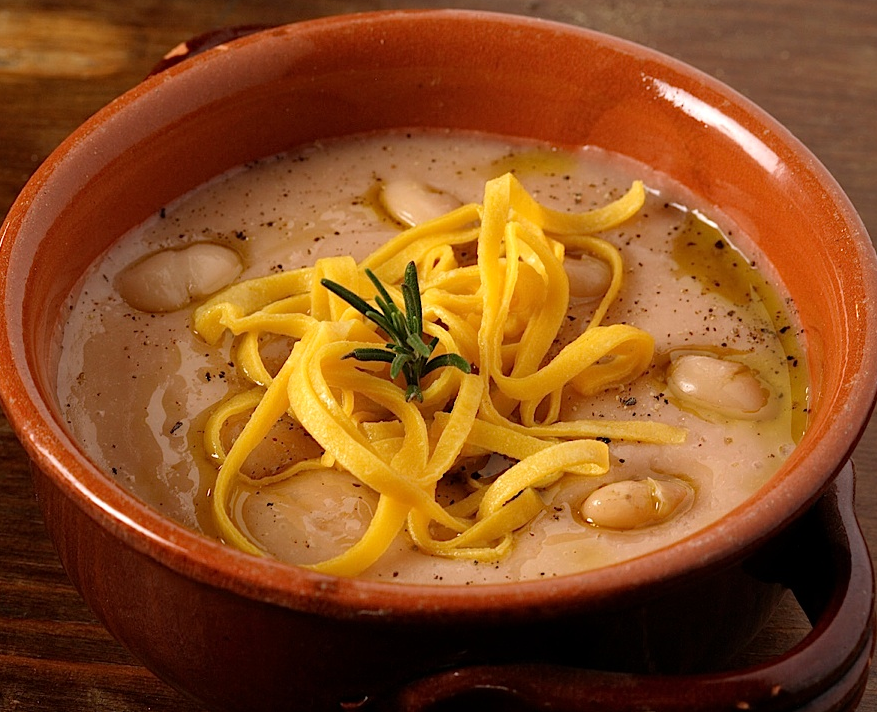The notion that Italy is a land of many highly specific cuisines is demonstrably true, even if you only have a few days to explore. What they do with tripe in Rome is not the same as what they do with it in Chianti Classico, nor is the presence of risotto something you can take for granted as you travel south from the Veneto. On a recent visit, we had many opportunities to experience this first-hand, and are pleased to share some of these “don’t miss them if you’re there” restaurants.
In Venice, just off the main canal, two or three twists and turns in towards Campo San Bartolomia, sits Fiaschetteria Toscana, so-named because it was originally a Tuscan wine shop. It is now, perhaps too modestly, what the owner calls a taverna, but the food is marvelous, typical for the region, with most of the seafood coming from the nearby lagoon. Dinner with Bottega owner Sandro Bottega means a lively time, but it is hard to imagine a more authentic, intensely flavourful meal, no matter who you are with. Bottega looks around the tiny piazza and at the artesian well in the centre of the restaurant patio and says, “These are the best servers in Italy, and certainly this is my favourite restaurant in all of Venice.” Sogliole in saor (baby sole in sweet and sour sauce); Baccalà mantecato (whipped cod with braised leeks and polenta); Cappe longhe (flash-grilled razor clams); orate (gilt-head bream). With Bottega sauvignon blanc and then Brunello, and Ripasso just in time for the 36-month-old Parmigiano Reggiano and the Monte Veronese cheeses.
Sitting in the sweet little town of Pescantina, in the heart of the Veneto, is La Cicchetteria L’Oco Marin. Two brothers, Marco and Daniele Carli, do all the cooking, serving, and yes, clean up too. While he is making and rolling meatballs for the evening dinner service, Marco says, “It’s basically like our own home, here”. Just off the river that runs through the town, this tiny (20 seats, perhaps) osteria hits all the right notes. Great wine service, original takes on traditional tortellini (including an amazing house specialty that is, basically, fried tortellini served in a baked parmesan basket). The cheese is served first, four cheeses, actually, each with its own handmade condiment, making for a wide array of flavours that really get the appetite going. Cicchetti are small bites, and this place takes the concept into wonderful new places, all the while acknowledging its culinary roots. By 2:00 p.m., the chef is already putting the finishing touches on that night’s fresh pasta and signature veal meatballs.
Not far off the Arno River as it flows from Florence to Arezzo, right in the beating heart of Chianti, is Osteria dell’Acquolina. Billed as a classical Tuscan trattoria, the place boasts splendid views over the valley, the olive groves and vineyards, and, as elsewhere in Italy, it really helps if you know someone who knows how to get there. It is in a rustic, out of the way setting, and all the more charming for that. Papa al pomodoro, a mixture of day-old bread, reduced to crumbs, and mixed with fresh tomatoes into a kind of paste, drizzled with good olive oil, is a traditional waste not, want not Tuscan appetizer. Risotto this time of year is served with foraged mushrooms and pumpkin flowers. Tortelli is stuffed with stinging nettle and ricotta; rabbit cacciatore; roasted duck; a little bistecca. Yes, this is eating well.
Speaking of bistecca, there is the amazing Dario Cecchini. He made his way to fame as a butcher. Even Jamie Oliver did a pilgrimage to Cecchini’s place, called Antica Macelleria Cecchini in Chianti. The menu is all meat, all the time (although the ever-respectful Cecchini does offer vegetarian options). The restaurant features some great side dishes of local beans, roasted potatoes, certainly, but larger than life Cecchini has two wood-burning grills inside, reaching up to 800 degrees in temperature, upon which all the various cuts are grilled. “This is the best meat in the whole world, and we treat it with great respect,” Cecchini says. He is above all respectful of using the whole animal, so there are plenty of so-called “secondary” cuts to explore, along with the classic bistecca fiorentina. It is something to behold, the cook-butcher holding up two enormous steaks, one in each hand, and giving a celebratory speech, lauding the quality of the animal whose bounty the gathered are about to share. The outside patio includes two very long communal tables, and the steaks, chops, headcheese, shin, trotters, even corned beef tongue, all make for an energized evening. It is called McDario for lunch, and that does indeed mean they serve burgers until about 2:00 p.m.
Chef Francesco Berardinelli presides over the kitchen, the grounds, and the cooking school at Castello di Gabbiano’s on-property restaurant Il Cavaliere in Chianti. But you do not need to be a guest at the castello to partake in the scenery, Berardinelli’s deep Tuscan roots, and the food he prepares fresh daily. After leading a tour of the main farmer’s market in Florence, Berardinelli sits with a glass of Chianti Reserva and says, “Cooking for me is a job. But I’m very passionate about my job”. Chestnut flour gnocchetti; long string beans dashed with truffle oil; Cinghiale (wild boar, so plentiful here that electric fences surround many vineyards to keep them out); cappelletti, with a touch of cinnamon in the mix, really speak to the specific region of Chianti classic. Spit-roasted guinea fowl, a rack of lamb with figs, lemon and chickpea hummus—all begin to really tell a tale of a chef who knows his limits and how to gently push them to wonderful new places.















